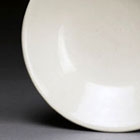J.J. Lally & Co., Oriental Art / New York City, New York
MenuPast Exhibition
Chinese Ceramics in Black and White
March 20–April 10, 2010
10.
AN INSCRIBED XINGYAO WHITE PORCELAIN BOWL
Tang Dynasty, A.D. 9th–early 10th Century
of well potted shallow circular form, with steeply rounded sides flaring out to a rounded and neatly finished lip, standing on a thick ring foot of bi-disc shape with chamfered edge, the underside of the foot unglazed revealing the very smooth white porcelain body, the clear glaze covering the interior and exterior showing a very pale bluish-silvery tone, the recessed center of the base also glazed and engraved before firing with a single character ying.
Diameter 61⁄2 inches (16.5 cm)
Chinese scholars have generally agreed that Tang dynasty white porcelains inscribed with the character ying were produced exclusively for imperial use. Wang Chanqi discusses this rare category of porcelains in “White Porcelains with Chinese Character Ying from the Qinglongsi Temple Site” first published in Kaogu yu wenwu, 1997, No. 6, pp. 6–12 and included by Zhang Zhizhong et. al. (ed.s) in Xingyao yanjiu (Xing Kiln Research), Beijing, 2007, pp. 332–337, analyzing a group of porcelains bearing the character ying which were excavated in 1992 in Xi’an, Shaanxi province at the site of the Qinglong Buddhist temple which enjoyed imperial patronage during the Tang dynasty. Wang concludes that porcelains inscribed with the character ying were reserved exclusively for the use of the emperor and were marked “ying” for the Tang imperial treasury called the “Da ying ku” (which may be translated as “The Storeroom of Great Abundance”). The Da ying ku is mentioned in Tang historical texts as the largest and most important of all the palace storerooms during the Tang dynasty. The ying marked porcelains discovered at the Qinglongsi site were most likely given to the temple as pious gifts directly from the emperor.
A fragmentary base from a white porcelain bowl of very similar form engraved with the character “ying” incised before firing in a similar quickly written regular script style, was excavated at the Tang dynasty Daming Palace site in Xi’an, Shaanxi and is illustrated by Feng Xianming in Essays on Chinese Old Ceramics, Hong Kong, 1987, p. 191, pl. 10, described as Xingyao.
Another Chinese scholar, Zhi Guangzheng, in “Tang dai Xingyao gongci ‘ying’ zi yanjiu” (A Study of Tang Dynasty Xing Ware Tribute Porcelains Marked with the Character “Ying”), first published in Wenwu Chunqiu, No. 5, and included by Zhang Zhizhong, op. cit., pp. 474–480, states that the white porcelains from the Xing kilns in Hebei province first became imperial tribute wares in the Tianbo era (A.D. 742–756) and continued to be used as imperial tribute ware through the end of the Tang dynasty.
唐 邢窰「盈」字款白瓷碗 徑 16.5 厘米
